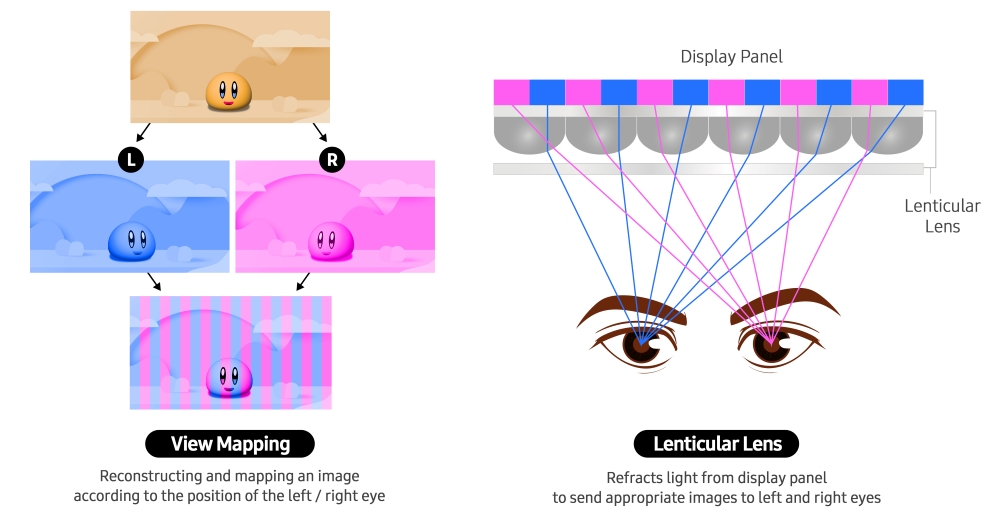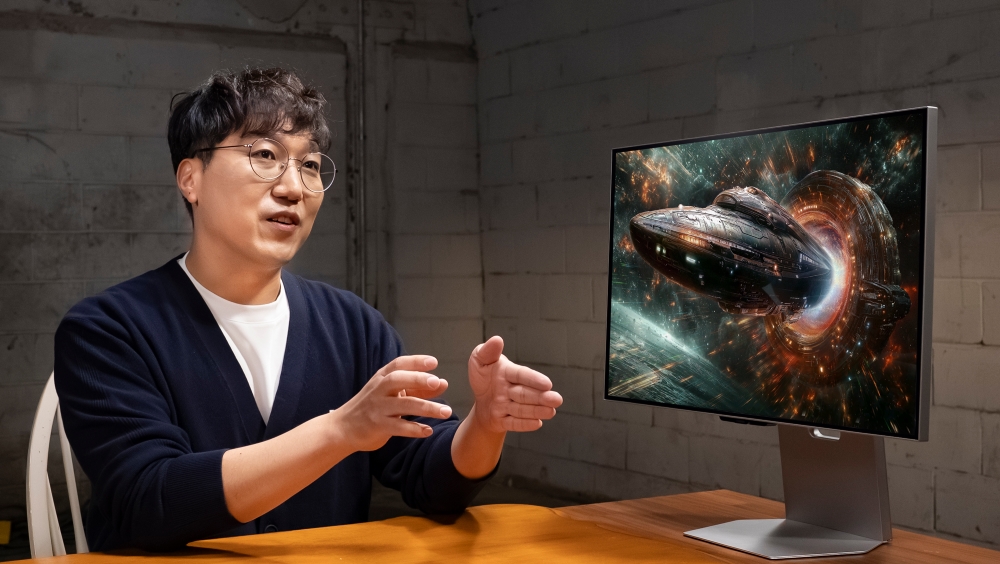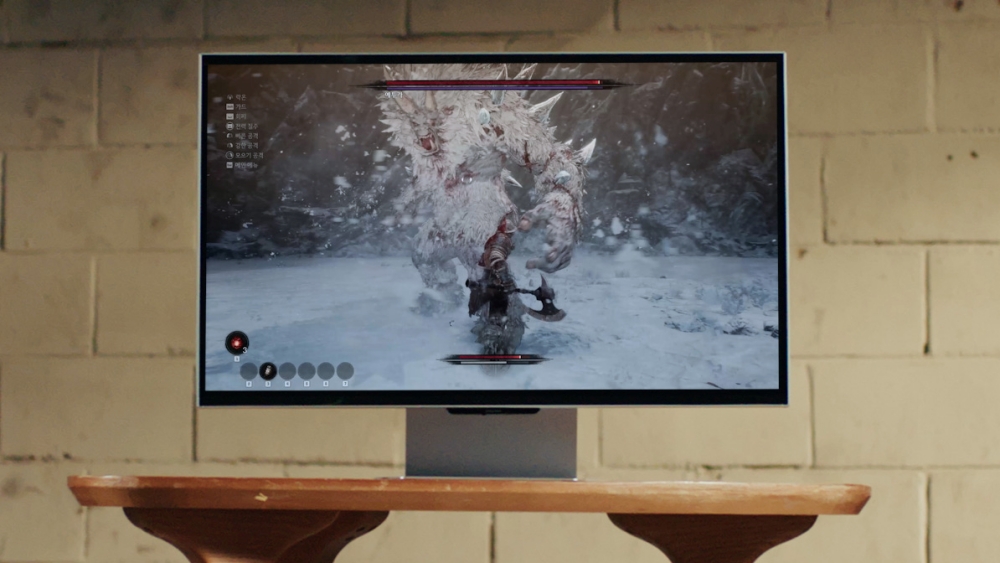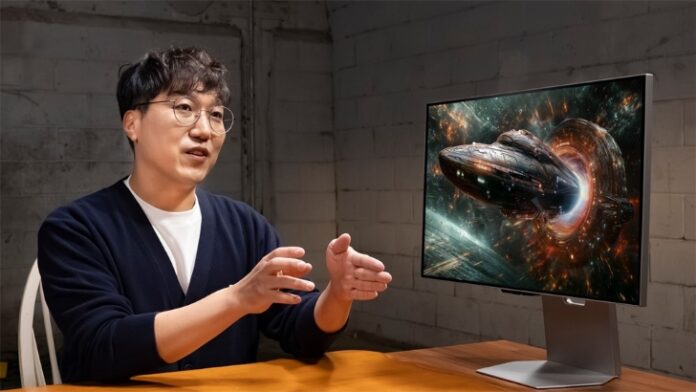“The Odyssey 3D marks the beginning of a new era of experiences.”
— Taekwan Lee, Samsung Electronics
3D content has often been associated with inconvenience. Enjoying it typically required specialized equipment such as 3D glasses or head-mounted displays (HMDs). Imperfections in the delivery of 3D images caused crosstalk, potentially leading to dizziness. These discomforts would chip away the immersion of 3D content.
Samsung Electronics is changing that narrative with the introduction of the Odyssey 3D (G90XF) — a finely tuned glasses-free 3D gaming monitor. Featuring eye-tracking and view-mapping technology, the Odyssey 3D marks a paradigm shift in immersive viewing and gaming experiences.
Samsung Newsroom sat down with Donghwa Lim from the Enterprise R&D Lab and Taekwan Lee from the Product Innovation Lab, both part of the Visual Display (VD) Business at Samsung Electronics, to discuss how the Odyssey 3D is redefining perceptions of 3D.
The Three Core Technologies Behind Odyssey 3D
3D displays create a sense of dimension using binocular disparity, in which the brain perceives depth by processing the slightly different images seen by each eye. Leveraging this principle, the Odyssey 3D delivers a glasses-free 3D experience by precisely presenting different images to each eye without the need for external equipment. The eye-tracking technology is designed to recognize users’ eyes even when they are wearing glasses.
“It’s incredibly rewarding to bring to market a technology that once seemed out of reach.”
— Donghwa Lim, Samsung Electronics
At the heart of the Odyssey 3D are three key technologies — eye tracking, view mapping and a lenticular lens.
▲ Odyssey 3D features a myriad of technologies to deliver an immersive, glasses-free 3D experience
Eye tracking is enabled by a stereo camera mounted at the top of the monitor, detecting and tracking the user’s eye movements in real time.
“Because the two cameras capture different images, much like human eyes, they can determine the exact position of the user’s eyes and distance between the eyes and the monitor in real time,” said Lim. “This real-time eye position detection allows us to deliver a precise 3D image, even when the user moves.”

▲ (From left) View mapping and the lenticular lens
Based on this data, the system calculates the correct pixel positioning for each eye and reconstructs a single image through a process called view mapping. The final mapped images are then separately delivered to each eye through the lenticular lens, allowing the images from the display panels to be visible to each eye by utilizing light refraction.
What’s more, the Odyssey 3D isn’t limited to 3D gameplay alone. Since the Odyssey 3D was developed as a gaming monitor, it performs exceptionally well in terms of picture quality and response speed, even when used for 2D gameplay. The lenticular lens activates only when a 3D mode is enabled by Reality Hub.
Minimizing Crosstalk With Samsung’s Advanced Display Technology
While 3D effects offer new levels of immersion, even minor visual inconsistencies can disrupt the experience. Samsung has dedicated significant resources to ensuring premium 3D visuals.
“Crosstalk occurs when the images perceived by the left and right eyes aren’t properly aligned,” said Lim. “It can lead to dizziness and other visual discomforts, so we developed several techniques to reduce it.”

▲ Donghwa Lim, Enterprise R&D Lab, Visual Display Business at Samsung Electronics, explains how technologies were meticulously put together to minimize crosstalk
“Even the slightest misalignments during the production or assembly of camera and display components can affect image accuracy,” he noted. “To address this, Samsung applies post-assembly calibration for both the camera and display panel and stores unit-specific data into a dedicated chip inside the monitor.”
In addition to hardware calibration, the Odyssey 3D features a deep learning-based eye-tracking algorithm and a specially engineered display cell coating designed to reduce light distortion and glare — all contributing to minimizing crosstalk and delivering a refined 3D experience.
Driving 3D Gaming Innovation Through Industry Partnerships
The true strength of the Odyssey 3D comes to life during gameplay. To bring immersive and personalized gaming experiences to users, Samsung is actively collaborating with industry partners to optimize games for glasses-free 3D.
“When industry-leading companies join forces, the benefits are ultimately passed on to gamers.”
— Taekwan Lee, Samsung Electronics
In partnership with Microsoft and virtual reality (VR) company Zero Density, Samsung has made high-quality 3D gaming content available through Reality Hub — a Windows-based 3D content platform that also supports the conversion of 2D photos and videos into 3D.

▲ Taekwan Lee, Product Innovation Lab, Visual Display Business at Samsung Electronics, explains that cross-industry efforts are key in expanding the 3D market
Joint efforts are also underway to expand 3D gaming content.
“Game developers are constantly exploring ways to offer new experiences to users,” said Lee. “One of those directions is 3D gaming.”
While the 3D gaming market is still emerging, Lee emphasized that industry-wide collaboration is key to accelerating its growth.
“The First Berserker: Khazan” — a recently published game developed by Nexon Korea and Neople — stands as a notable example of how 3D immersion can come to life through collaboration with Samsung during development.
“Through this partnership, Nexon, Neople and Samsung have been working closely to tailor the 3D visuals, carefully adjusting them based on the composition of characters and backgrounds. We ensured that everything from scene-specific factors to cinematic transitions could be presented more vividly on Odyssey 3D monitor,” he explained.

▲ A scene from “The First Berserker: Khazan”
“Creating effects like drifting particles, fast-moving flames and cinematic cutscenes1 was technically challenging, but I’m proud of what we achieved through teamwork,” Lee added. “In particular, the snowy mountain scene in Khazan gives the impression that snowflakes are flying directly toward the player when played on the Odyssey 3D. It’s an experience I would strongly recommend trying firsthand.”
“Our research is a journey to connect users to the future.”
— Taekwan Lee, Samsung Electronics
With the Odyssey 3D, Samsung is elevating the gaming experience to new levels of immersion.
“We are in discussions with local and global game developers to expand the 3D gaming market,” he emphasized. “Our goal is to collaborate with more developers to bring a broader range of 3D games to users. When industry-leading companies join forces, the benefits are ultimately passed on to gamers.”
From Impossible to Possible: Leading the Future of 3D Monitors
Lim reflected on how far technology has come over the past decade.
“Way back when I first joined Samsung, I attended a meeting on 3D technology where the lenticular lens was deemed ‘not feasible’ with existing technology,” he said. “Now, years later, we’ve not only made it possible, but we’ve also brought it to market. It’s incredibly remarkable and deeply rewarding to see a product launch built on technology that once seemed out of reach.”

▲ Donghwa Lim and Taekwan Lee are excited about the market potential of 3D content and monitors
“Our research to create new experiences is a journey to connect users to the future. The Odyssey 3D marks the beginning of a new era in expanding the boundaries of technology-driven experiences,” said Lee. “Games played on the Odyssey 3D are sure to deliver a ‘wow’ factor — not just at specific moments, but throughout the entire experience.”
As Samsung continues to lead the gaming monitor market, the Odyssey 3D stands as a powerful example of how the company is redefining immersive experiences and pushing the limits of display innovation.
1 Short storytelling clips shown between stages during gameplay.


